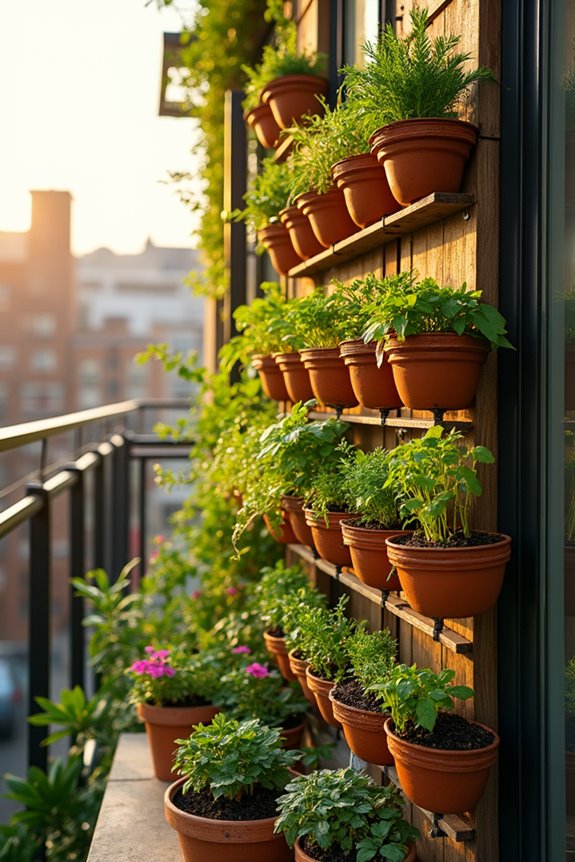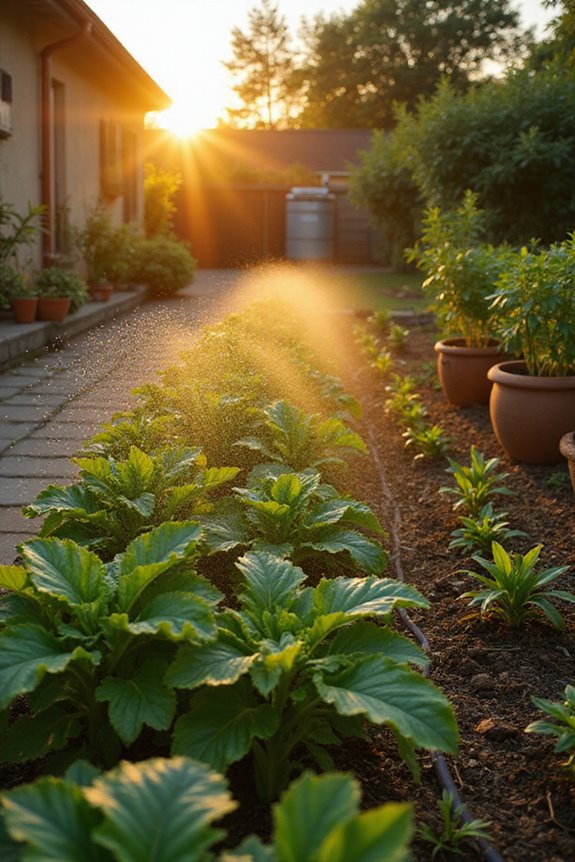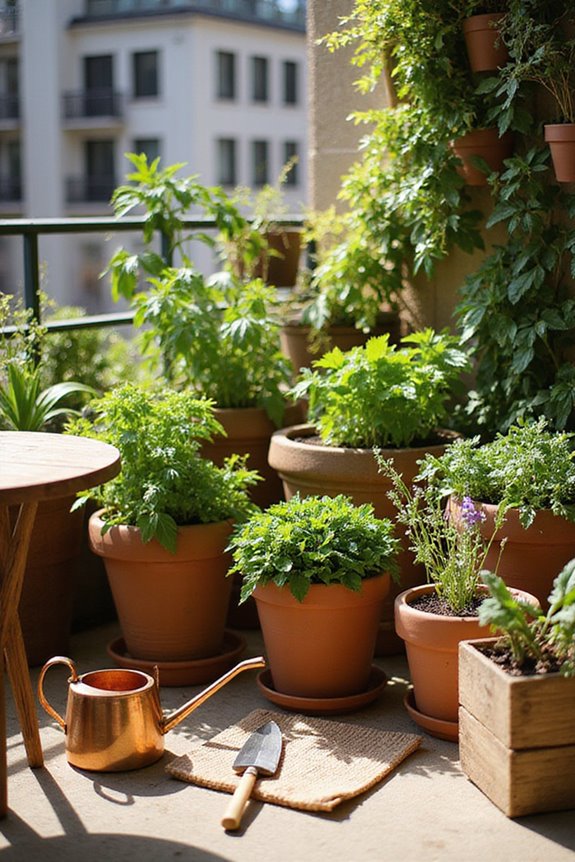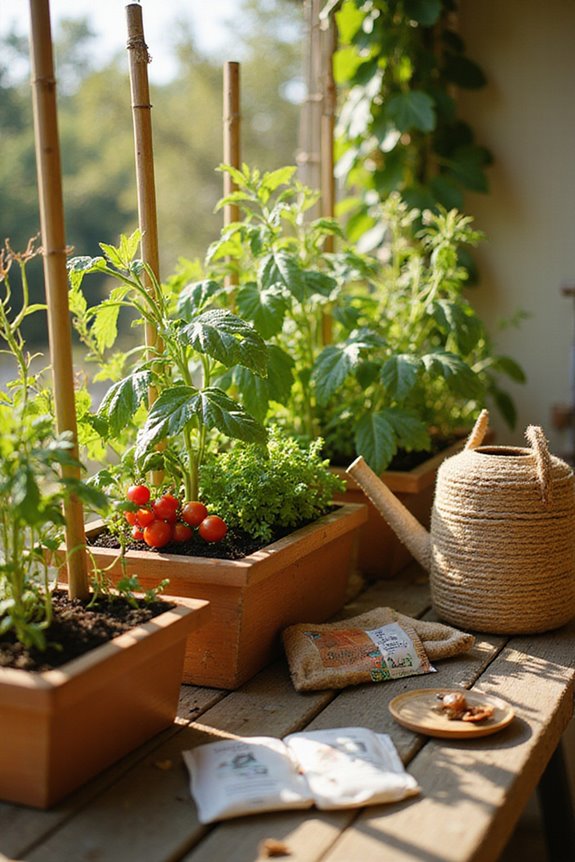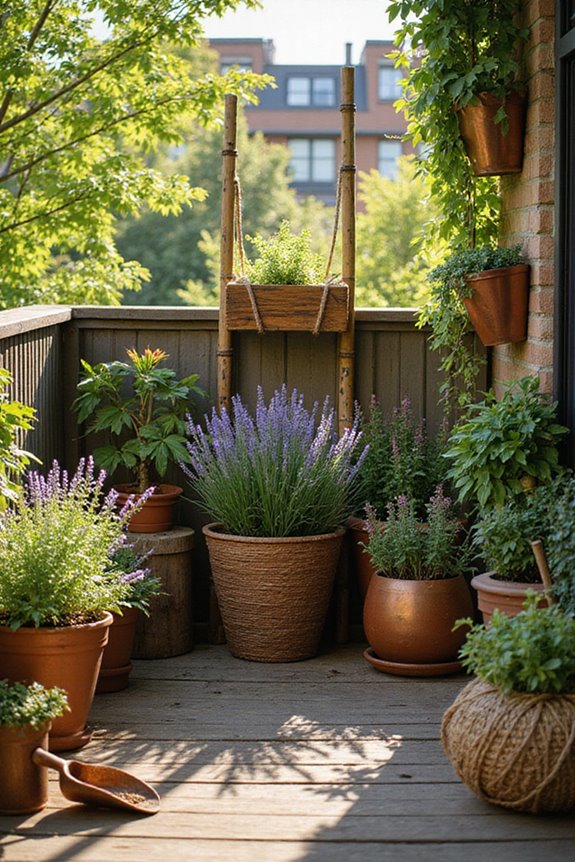Advanced container garden designs focus on key principles and creative choices to enhance beauty and functionality. We can layer plants by height, placing tall ones at the back and shorter ones in front. Using innovative containers, like old bird baths or toolboxes, can add character. Grouping plants with similar needs guarantees healthy growth, while seasonal shifts can create interest. By exploring more about these strategies, we can elevate our container gardening projects even further.
Key Takeaways
- Incorporate plant height variations by using “thrillers,” “fillers,” and “spillers” to create dynamic visual interest in container arrangements.
- Utilize creative containers like repurposed items or unique shapes to enhance aesthetic appeal and individuality in your garden design.
- Implement vertical gardening techniques to maximize space while adding layers and depth to your container garden.
- Group plants with similar care requirements and ensure adequate spacing for healthy growth and maintenance ease.
- Design themed mini-landscapes that adapt seasonally, incorporating contrasting textures and colors for year-round visual appeal.
Design Principles for Container Gardens
Creating an appealing container garden requires a solid grasp of design principles. First, we should consider plant height. Tall plants, like ornamental grasses, serve as “thrillers,” while trailing plants, or “spillers,” create a soft, cascading effect. This combination adds visual interest and depth to our design.
Next, we need to focus on spatial layering. We can arrange taller plants at the back, medium plants in the middle, and low, trailing plants in front. This strategy guarantees that every plant is visible and contributes to a balanced look.
Lastly, let’s remember to group containers of varying sizes for a cohesive visual effect. This approach enriches our garden and creates an inviting atmosphere for everyone to enjoy. Additionally, mixing heights and textures can enhance the overall aesthetic and provide a more dynamic look to your container arrangements.
Innovative Plant Selections
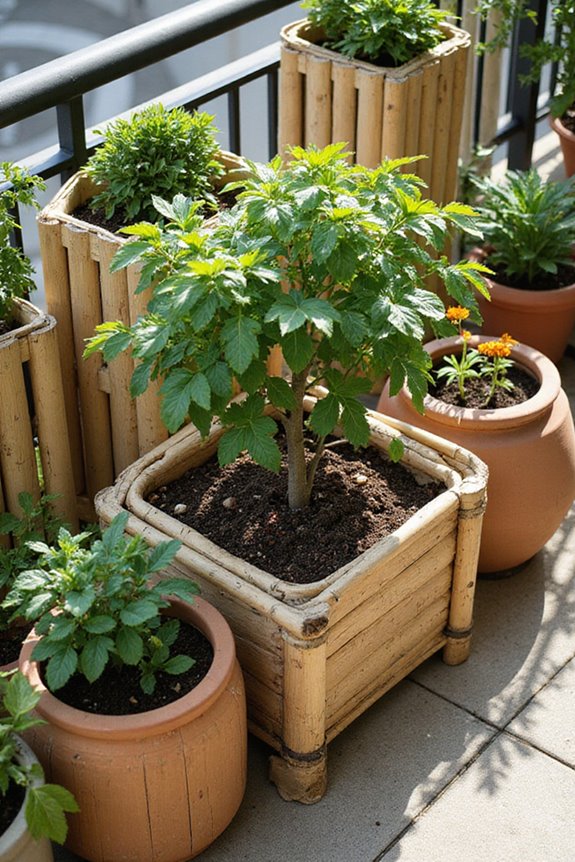
When we think about innovative plant selections for our container gardens, it’s important to take into account a variety of options that can enhance both aesthetics and functionality. For instance, plants like Golden creeping Jenny offer unique foliage with vibrant gold leaves that cascade beautifully. Meanwhile, Japanese pieris adds seasonal fragrances with its delicate white blossoms in spring.
We can also consider the striking colors of Canna and Caladium varieties, which enhance container appeal. Variegated Miscanthus grasses provide subtle texture, while fragrant Agastache flowers attract pollinators. By choosing a mix of these plants, we not only create visual interest but also enrich our garden’s sensory experience. Together, these selections transform our containers into lively, inviting spaces.
Creative Container Utilization
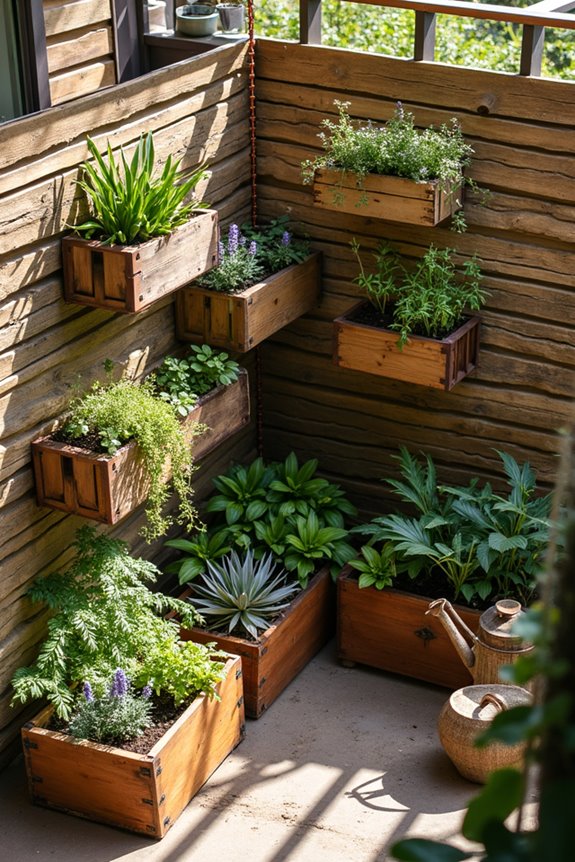
Creative container utilization can transform how we approach gardening, especially in limited spaces. By embracing upcycling materials, we can create stunning container aesthetics while being environmentally conscious. Here are some ideas:
- Repurpose Everyday Items: Use old bird baths for succulents or toolboxes as portable gardens.
- Vertical Gardens: Attach containers to walls or use hanging baskets to save space.
- Unique Containers: Transform old mailboxes or half-whiskey barrels into quirky planters.
- Textured Arrangements: Employ concrete blocks for varied height in container designs.
- Creative Placement: Cluster containers to hide unsightly elements and guide visual flow. Additionally, incorporating drainage systems in your container designs can enhance plant health by preventing waterlogging and promoting robust growth.
Functional Design and Maintenance
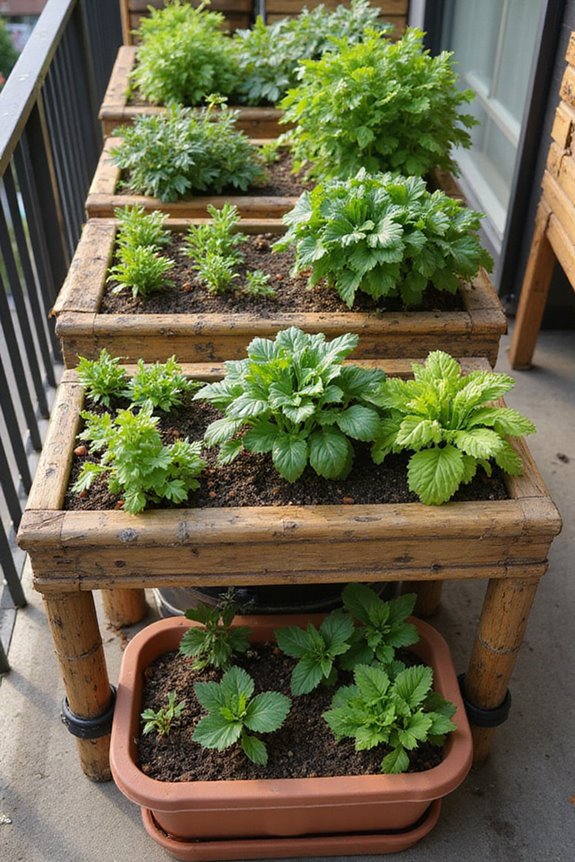
Functional design and maintenance are essential for successful container gardening. To guarantee healthy plant growth, we need to take into account plant spacing. Grouping plants with similar needs in compatible containers reduces maintenance and promotes health.
Container rotation is also important. By periodically moving containers, we can guarantee even sunlight exposure and encourage balanced growth. We should also choose containers with adequate drainage and the right materials to prevent root overheating. Additionally, selecting well-draining potting mixes is crucial for optimal growth and health.
Regular maintenance is key. We must inspect for dead foliage and pests, prune plants as needed, and clean containers between planting cycles. With these strategies, we can create a thriving container garden that’s not only beautiful but easier to manage. Let’s work together to enjoy our gardening journey!
Seasonal and Thematic Design Strategies
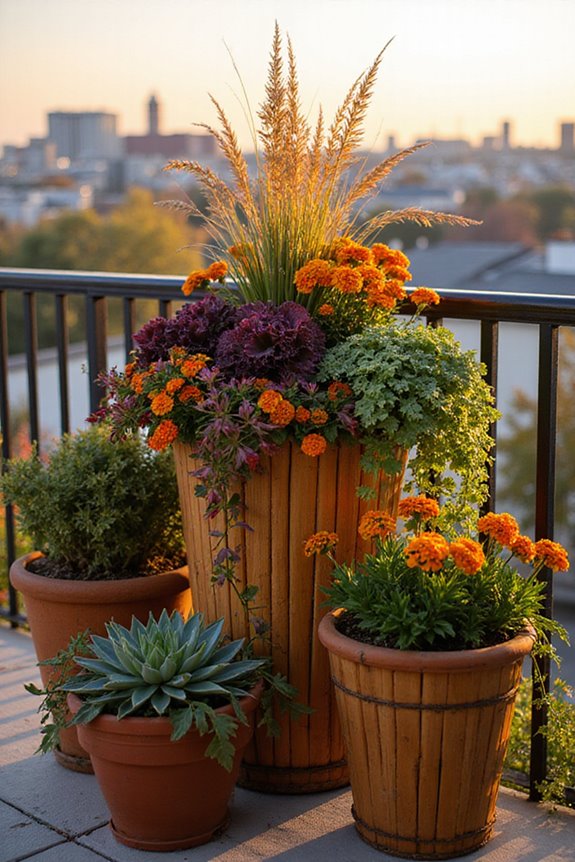
Creating a container garden that reflects the changing seasons adds visual interest and variety to our outdoor spaces. We can start with a strong foundation using evergreens, which provide year-round structure. Around these, we can add vibrant seasonal color plants to create lively displays.
- Use early spring bulbs like Muscari paired with violas for a smooth seasonal shift.
- Design mini-landscape containers with thematic palettes, such as sun-loving plants for summer or warm autumn hues for fall.
- Implement contrasting foliage and textures to maintain visual appeal as blooms change. Additionally, incorporating seasonal adaptability into your layout can enhance the overall design and functionality of your container garden.
Advanced Techniques in Container Gardening
What advanced techniques can we utilize to enhance our container gardening experience? First, vertical gardening is a fantastic way to maximize space. We can use trellises or vertical planters like the GreenStalk system to grow multiple plants in a small area. Climbing crops such as beans thrive on these supports, improving air circulation and yield.
Another innovative approach is integrating hydroponic systems. These soilless methods deliver nutrients directly to plant roots, resulting in faster growth and healthier plants. Plus, they conserve water efficiently. The use of self-watering systems ensures that plants receive consistent moisture without the need for frequent manual watering.
We can also repurpose everyday items as containers. Old bird baths or toolboxes can become unique planters. With these techniques, we can create thriving container gardens that are both beautiful and productive.
Integrating Technology and Planning Tools
Integrating technology into our container gardening practices can greatly enhance our planning and management. By utilizing digital garden planning tools, we can access over 250 species with tailored growing guides. These tools enable us to draw layouts for container gardens and generate personalized planting charts based on local weather data.
Smart container technologies, like moisture sensors and automatic watering systems, help us maintain ideal soil moisture. Notifications guarantee we don’t miss vital plant care tasks.
Furthermore, specialized apps offer drag-and-drop features to visualize our designs and simulate plant growth. By incorporating climate data, we can better refine our planting schedules and strategies, leading to healthier yields. Embracing technology integration is key to our planning improvement in container gardening.
Frequently Asked Questions
How Do I Choose the Right Location for My Container Garden?
How do we find the perfect spot for our container garden? We should consider sunlight exposure and drainage considerations, ensuring our plants thrive while creating a welcoming space that brings us joy and connection.
What Are Some Common Pests That Affect Container Plants?
When it comes to common pests affecting our container plants, we should focus on pest prevention and explore organic solutions like neem oil and beneficial nematodes. Together, we can keep our gardens healthy and thriving!
How Often Should I Fertilize My Container Plants?
When we think about fertilizing our container plants, we should consider fertilizer types and application frequency. Generally, we’ll apply liquid fertilizers every 1-2 weeks, while slow-release options can last 3-4 months. Let’s keep our plants thriving!
Can I Use Regular Garden Soil in Containers?
We can’t use regular garden soil in containers. Its dense soil composition hinders container drainage, leading to root rot. Instead, let’s choose lightweight mixes that promote healthy growth and guarantee our plants thrive together.
What Is the Best Way to Winterize My Container Gardens?
As winter whispers its chill, we must embrace container insulation and winter protection. By wrapping our pots and clustering them together, we create warm refuges for our beloved plants, ensuring they thrive through the frosty months ahead.

